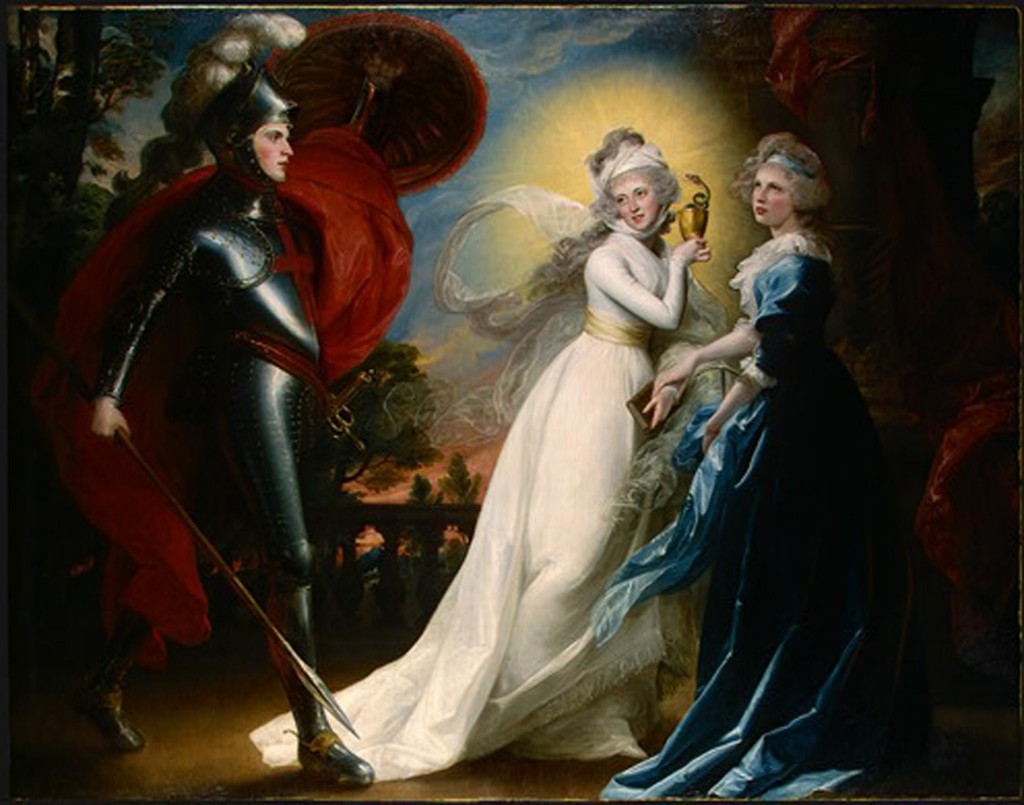
John Singleton Copely, The Red Cross Knight, 1793
With this post, Trevor Losh-Johnson joins us as a byline correspondent.
My orientation to romance is by way of The Faerie Queene, where many of the motifs of romance occur in a more condensed form. And, since Spenser crops up again and again in Frye, it might be worth posting some thoughts regarding the role of virginity in that poem, especially in its first book, which deals with the quest of the Redcrosse Knight.
As she is literally as pure as the driven snow, it is easy to take Una as a prototypical romantic virgin. In the third essay of Anatomy, Frye notes that Una’s parents, “are Adam and Eve; their kingdom is Eden or the unfallen world, and the dragon, who is the entire fallen world, is identified with the leviathan… Thus St. George’s mission, a repetition of that of Christ, is by killing the dragon to raise Eden in the wilderness and restore England to the status of Eden.” (194). Una’s black wimple, a hymen of sorts, is worn also as a mark of mourning for her parent’s fallen kingdom, and her marriage to Redcrosse (St. George) can only occur once her kingdom is restored. Indeed, once Redcrosse delivers the kingdom, her veil is lifted to reveal her face, and that deliverance is perhaps a public expression of the perennially deferred, private consummation with Redcrosse.
The doubling of heroines Joe speaks of occurs here in the context of demonic parody. Duessa, who is allegorically the Whore of Babylon, parodies Una, who is allegorically the one true faith. An essential function of Duessa is that she briefly tempts and enthralls Redcrosse from this ultimate consummation. As for the role of gender, virginity is expected of Redcrosse in the context of fidelity. The purgatorial House of Holiness is attended by, among many virtues, Fidelia and Speranza, who are also virgins. Their mother is, however, Caelia, who to “a louely fere/ Was lincked, and by him had many pledges dere.” There may be a buried analogy between the virgin Fidelity in her married mother’s House of Holiness and the virgin Una who shall be married and inherit the regenerated society of her parents.
In the third book, the virtue of Chastity is also framed in the context of fidelity, and it is expected that there will be lots of sex when Britomart finally unites with Artegall. It is noteworthy that Britomart is to embody the virtue of Chastity, and not the flat virginity that Una embodies until her kingdom is released. But this may have its basis less in the manifold politics of gender than in the structure of the allegorical romance. Generally, as far as I can dimly see, the characters and stations that populate the quest are objectified projections of the central figure. In this solipsistic world, Redcrosse is anatomized by the other characters, and Una’s virginity may be a static expression of his own chastity. To whatever extent this can be said, I think that the progress of the first book’s quest may be read as an alignment between the progress from the fallen world to Eden and the progress from a hostile virginity to sexual chastity. It also parallels the process of condensation from the literature of doppelganger heroines to the chastity of Adam and Eve that Frye explores in Words With Power.
As convoluted as this may sound, there seems to be in romance a connection between the upwards movement from virginity to chastity and Frye’s discussion of the Eden metaphor, to wit, “What is significant is the way in which poets preserve and emphasize the metaphorical identity of the bride’s body and the garden, which enables them to associate sexual emotion with visions of a renewed nature.” (198).
